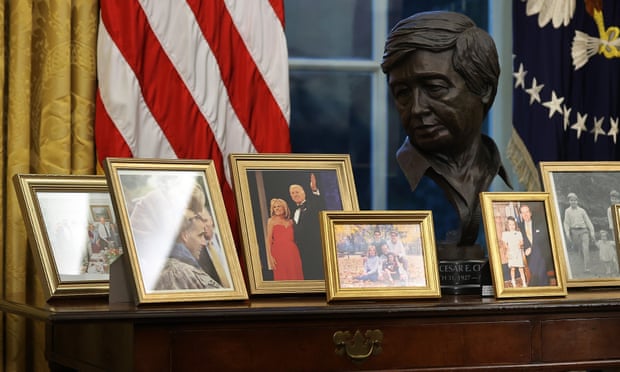President Biden’s personal touches in the Oval Office include replacing a portrait of Andrew Jackson and adding a bust of labor icon Cesar Chavez behind the Resolute Desk, according to The Washington Post.
The new layout includes busts of Martin Luther King Jr. and Robert F. Kennedy on either side of the fireplace as well as the Chavez bust. Other busts in the office include Rosa Parks and Eleanor Roosevelt.
A portrait of Jackson, the seventh president, has been removed and replaced with a portrait of Benjamin Franklin. Trump has frequently identified with Jackson, who was elected president on a populist platform and railed against entrenched interests, while critics have pointed to his brutal policies against indigenous people and his participation in the slave trade.
Highlighting Biden’s emphasis on national unity, paintings of Alexander Hamilton and Thomas Jefferson, fierce rivals in life, are in close proximity to each other as part of the redecoration. They are intended “as hallmarks of how differences of opinion, expressed within the guardrails of the Republic, are essential to democracy,” Biden’s office told the Post.
Directly across from the Resolute Desk sits a portrait of Franklin Roosevelt, who, like Biden, took office amid multiple crises, including the Great Depression and the gathering clouds of World War II in Europe.
Such redesigns are standard procedure for a new administration, but Biden’s Oval Office contains more representations of historical figures than average, according to the newspaper.
“It was important for President Biden to walk into an Oval that looked like America and started to show the landscape of who he is going to be as president,” Deputy Director of Oval Office Operations Ashley Williams told the newspaper.
Source: The Hill
Who Is Cesar Chavez?
Mexican American Cesar Chavez (1927-1993) was a prominent union leader and labor organizer. Hardened by his early experience as a manual laborer, Chavez founded the National Farm Workers Association in 1962.
His union joined with the Agricultural Workers Organizing Committee in its first strike against grape growers in California, and the two organizations later merged to become the United Farm Workers. Stressing nonviolent methods,
Chavez drew attention for his causes via boycotts, marches and hunger strikes. Despite conflicts with the Teamsters union and legal barriers, he was able to secure raises and improve conditions for farm workers in California, Texas, Arizona and Florida.
Cesar Chavez – Wikipedia
